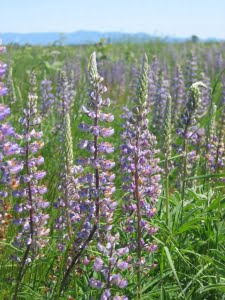
Lupinus oreganus: Population Monitoring, Reintroduction Success and Evaluation of Experimental Treatments
 |
| Lupinus oreganus inflorescences |
Scientific Name: Lupinus oreganus A. Heller; formerly known as Lupinus sulphureus Douglas ex Hook. var. kincaidii (C.P. Sm.) C.L. Hitchc.
Species Listing Status: The Oregon Department of Agriculture and the U.S. Fish and Wildlife Service have listed Lupinus oreganus as a threatened species. However, the majority of sites where it is known to occur are on private lands, which are exempt from state and federal protections.
Distribution: Lupinus oreganus is found in native prairie remnants and oak woodlands of the Willamette Valley as well as southwestern Washington and Douglas County, Oregon.
Project Description: IAE devotes a significant portion of the field research season to monitoring Lupinus oreganus throughout its range in Oregon. This year, we monitored several sites within the West Eugene Wetlands, and the Eugene and Roseburg BLM Districts. The species is threatened by shrub encroachment, exotic invasive plants and ORV use. The sites are currently under various management treatments including: mowing, burning, solarization, weed removal and tree removal. Our research involves measuring the total ground cover and counting the number of racemes on the plants. This information will be used to determine the best management treatment or combination of treatments to support these populations.
 |
| Vegetative Lupinus oreganus |
Identification tips: Lupinus oreganus can be distinguished from other co-occurring lupine species through the combination of several features. It has palmately compound leaves with several leaflets which are glabrous on the upper surface. Flowering from April through June, the unbranched inflorescence has numerous purplish flowers which occur in a raceme. Secondarily, the pungent, sulfurous smell of this species can be used as a distinguishing characteristic.
Interesting Facts: Lupinus oreganus is an obligate larval host for the Fender’s blue butterfly (Icaricia icarioides fenderi), a federally listed endangered animal. The Fender’s blue butterfly oviposits small, white eggs on the undersides of L. oreganus leaves. Once the eggs hatch, the larvae feed on the leaves and overwinter in the soil at the base of the plants.
The full reports are available for each location where we monitored for Lupinus oreganus var. kincaidiiand can be found at https://appliedeco.org/reports.
